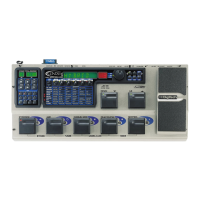bottom turn around point for the LFO (not available when volume is the assigned parameter).
5. Rotate the Parameter 3 knob to select the maximum value the assigned parameter reaches at the top
turn around point for the LFO (not available when volume is the assigned parameter).
6. Rotate the Parameter 4 knob to select the speed that the LFO oscillates from the minimum to the
maximum values. LFO speed ranges from (
.O5 HZ) to 10 Hz (1ºO HZ).
7. Rotate the Parameter 5 knob to select the waveform the LFO oscillates on. Your choices include:
triangle (Triangle) - a smooth rise and fall, but abrupt turn around in oscillation.
SINE (Sine) - a smooth rise, fall, and turn around in oscillation.
SQUARE (Square) - an abrupt rise, fall, and turn around in oscillation.
8. Store your LFO assignment to your preset. See page 17 for more information on the storing
procedure.
Amp Footswitch
From the factory, the Amp Footswitch switches between the Green and the Red Amp Channels. However,
the GNX3 lets you select the Amp Footswitch function. The procedure for assigning the function of the
Amp Footswitch is as follows:
1. Press either EFFECT SELECT button until the Exp Assign row is selected.
2. Press the STATUS button until the display reads
AMP FS (Amp Footswitch).
3. Rotate the Parameter 1 knob to select the Amp Footswitch function. Your choices include:
G-R - Switches between the Green and Red Amp Channels.
G-Y - Switches between the Green and Yellow (Warped) Channels.
R-Y - Switches between the Red and Yellow (Warped) Channels.
G-R-Y - Switches between the Green, Red, and Yellow (Warped) Channels.
4. Store your Amp Footswitch assignment to your preset. See page 17 for more information on the
storing.
Control Footswitch
When using the GNX3 in Stompbox mode, FOOTSWITCH 5 becomes a Control Footswitch. This
provides even more real-time expressive control during performance when used in conjunction with the
Expression pedal. Up to three 3 parameters can be controlled between two different values in each
preset using the Control footswitch. The Control footswitch can function in two different ways, as a
To ggle footswitch or as a Momentary footswitch.
When using the Toggle function, the Control footswitch behaves like a normal footswitch in that it
switches to and ON state when pressed once and then an OFF state when pressed again. This type of
function is useful when you want to use it for turning effects like the Compressor or Whammy on and
off. It can also be used to toggle between two different parameter settings, for instance, a delay level of
10 or a Delay level of 50.
When using the Momentary function, the Control footswitch switches ON as long as it is being pressed,
and turns OFF when it is released. Experimenting with different parameters can produce some very
interesting results. For instance, you can assign Pitch Shift amount and have your guitar shift from a fifth
above when the Control footswitch is pressed and return to normal pitch when it is released. The
procedure for assigning the Control footswitch in the GNX3 is as follows:
1. Press either EFFECT SELECT button until the Exp Assign row is selected.
2. Press the STATUS button until Control footswitch assignment #1 is displayed,
ctrl1 fs (Pressing
the STATUS button again accesses assignments #2 and #3).
63
Other Functions

